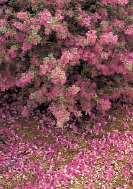
![]() chapter THREE
chapter THREE ![]()
Success with Desert Plants
Gardeners living in the Coachella Valley have a wide selection of perennials to chose from—both cultivated varieties as well as native wildflowers. Selections of each are described here.
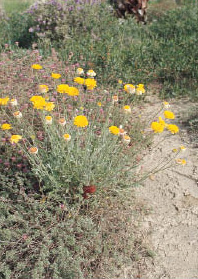
desert marigold |
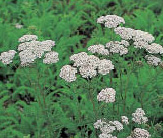
woolly yarrow |
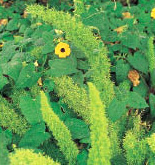
asparagus fern ‘Myers’ |
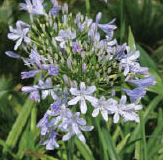
lily-of-the-nile |
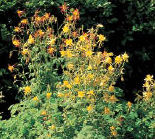
columbine |
|
Botanical Name Common Name |
How to Grow Water, Sun, Temp. |
Description Mature Size Flowers Bloom Season |
||
|---|---|---|---|---|
Achillea tomentosa woolly yarrow |
 |
 |
10° | Grows 1 to 2 feet high with gray-green leaves. Large delicate flowers on long stems may be salmon, yellow, lavender or white. Locate where plants will receive afternoon shade in a rich, organic soil. Cut back winter-dormant plants for regrowth the following spring. |
Agapanthus orientalis lily-of-the-nile |
 |
 |
15° | Produces large clusters of blue flowers on 2-foot stems surrounded by dark green, straplike, evergreen leaves. Fleshy roots store moisture. Effective in containers as well as in a natural garden design. Locate where plants will receive afternoon shade; they burn in summer sun in low desert. |
Aquilegia hybrids columbine |
 |
0° | Produces large clusters of blue flowers on 2-foot stems surrounded by dark green, straplike, evergreen leaves. Fleshy roots store moisture. Effective in containers as well as in a natural garden design. Locate where plants will receive afternoon shade. Attracts hummingbirds. | |
Artemisia schmidtiana angel’s hair |
 |
20° | ‘Silver Mound’ is low growing to 1 foot high with interesting, silvery gray, fernlike evergreen leaves. Excellent for rock garden or borders, especially in contrast with brightly colored flowers. Prefers a sunny exposure. | |
Asparagus densiflorus asparagus fern |
 |
24° | ‘Sprengeri’ has small leaves on arching branches, forming a rich, fluffy, bright green mound. Use as ground cover, border, filler or in containers. Accepts exposure ranging from shade to full sun. ’Myers’ is similar but more refined with dense, clean, plumelike stems. | |
Asparagus macowanii Macowan asparagus FERN |
 |
25° | (A. myriocladus, A. retrofractus). Tufts of rich, green, threadlike foliage resembles billows of green smoke. Many long, slender stems 1-1/2 to 2 feet long rise in clumps that form tuberous roots. Plant in shade only. Makes a nice backdrop to colorful annuals. | |
Asparagus setaceus fern asparagus |
 |
25° | (A. plumosus). A vigorous plant with small, dainty, lacy, fernlike leaves that are deep green. Good cut foliage for indoor arrangements. Climbing, vining growth or use as ground cover. Plant in shade only. | |
Baileya multiradiata desert marigold |
 |
10° | Grows 1 to 1-1/2 feet high, with bright yellow, daisylike flowers that bloom almost continuously from spring to fall on tall stems. Woolly gray leaves form a clump to 6 inches high. Cut back in winter to stimulate new growth and flowers in spring. Reseeds readily. Seeds attract birds. | |
Bergenia crassifolia siberian tea |
 |
10° | Forms clumps to 1-1/2 feet high and 2 feet wide. The large, round leaves have wavy edges. Rose, lilac or purple flower spikes to 18 inches high bloom in January and February. Use as edging or ground cover in shade. | |
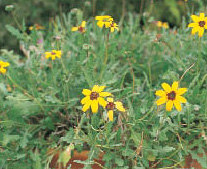
marguerite |
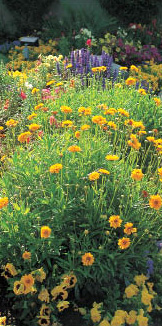 lance-leaf Coreopsis |
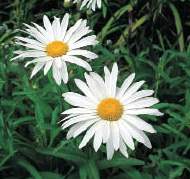
shasta daisy |
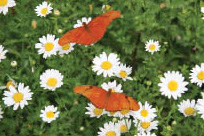
chocolate flower |
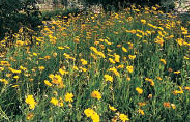
‘Zagreb’ coreopsis |
| Botanical Name Common Name |
How to Grow Water, Sun, Temp. |
Description Mature Size Flowers Bloom Season |
||
|---|---|---|---|---|
Berlandiera lyrata chocolate flower |
 |
10° | To 1-1/2 feet high with 2-foot spread. Sprays of flowers in shades of yellow bloom spring to early summer and produce a fragrance similar to chocolate. Flower heads expand in morning, drooping in afternoon. Leaves are green above, whitish underneath—combine with other gray-leaved plants. | |
Centaurea cineraria dusty miller |
 |
10° | Compact growth to 2 feet high. Velvety white leaves have broad, roundish lobes. Solitary flower heads are purple or yellow. Plant in full sun. Good soil drainage important. Be aware there are several different plants known by the common name dusty miller. | |
Cerastium tomentosum snow-in-summer |
 |
 |
0° | Grows to just 4 to 6 inches high with soft, whitish gray leaves. Small white flowers to 3/4-inch across bloom late spring into summer. For good contrast combine with green-foliaged plants. Trim spent flowers and tired stems at least once each year after flowering. |
Chrysanthemum frutescens marguerite |
 |
20° | A perennial but typically grown as an annual in the Coachella Valley. It reaches 2 to 3 feet high and as wide, becoming almost shrublike. Available in white, yellow or pink flowering forms, each offset by bright green divided leaves. Plant from October through February for spring flowers into April. | |
Chrysanthemum X superbum shasta daisy |
 |
-20° | (C. maximum). White ray flowers surround yellow disks. The stem is straight or slightly branched and the basal leaves are deeply toothed. Plant from containers in spring or fall. Attractive in borders and as cut flowers. Divide plants every two years to develop more vigorous growth. | |
Clivia miniata kaffir lily |
 |
25° | Orange flowers bloom in clusters on stout stems to 2 feet high in early spring. Leaves of Belgian hybrids are wider, dark green. For best flowers, let them grow undisturbed, forming large clumps. Great container specimen. | |
Coreopsis lanceolata lance-leaf coreopsis |
 |
10° | Plants grow to 2 feet high with yellow daisylike flowers on long stems that bloom spring into early summer. ‘Early Sunrise’ grows to 1-1/2 feet high with double golden yellow flowers. Coreopsis are great border plants or cut flowers. Plant in full sun in regular garden soil. | |
Coreopsis verticillata ‘Zagreb’ Coreopsis |
 |
10° | Grows to 1 foot high and about 2 feet wide. Golden yellow flowers bloom on tall stems, contrasting nicely with bright green leaves. Flowering season is long—late spring to fall. Birds, including goldfinches, are attracted to the seeds. | |
Dicliptera resupinata dicliptera |
 |
22° | Grows to 2 feet high and as wide. Rose-purple flowers bloom from May through October. Use in small garden areas such as patio or courtyard. Trim back after cold weather just prior to spring to renew growth. Dark green heart-shaped leaves are 1 inch long. Plant in well-drained soil. | |
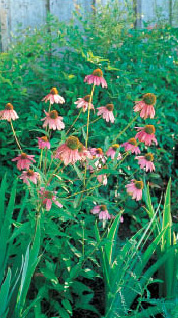
purple coneflower |
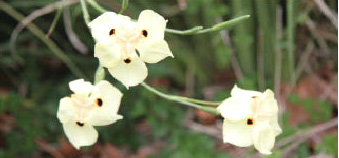
butterfly iris |
|
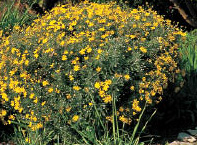
green gold |
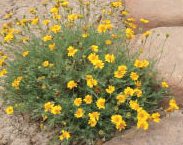
golden dyssodia |
|
| Botanical Name Common Name |
How to Grow Water, Sun, Temp. |
Description Mature Size Flowers Bloom Season |
||
|---|---|---|---|---|
Dietes bicolor peacock flower |
 |
25° | Plants grow from rhizomes to 2-1/2 feet high with stiff, upright leaves. Lemon yellow flowers with maroon spots bloom for several months during the warm season. Moderate water use, but more flowers with more moisture. | |
Dietes vegeta butterfly iris |
 |
 |
25° | (Moraea vegeta, M. iridoides). Similar to Dietes bicolor. Evergreen perennial from rhizomes to 2 feet high with stiff upright leaves. Small, white, irislike flowers bloom spring to fall. Accepts full sun to partial shade. |
Dyssodia pentachaeta Golden dyssodia (Thymophylla pentachaeta) |
 |
10° | Small-scale perennial, growing to just 6 inches high and 1 foot wide. Medium green, needlelike leaves are the perfect backdrop to profuse, bright yellow, daisylike flowers that bloom spring into fall. Not fussy about soil. Combines well with cacti and succulents, or tucked into rock gardens. | |
Echinacea purpurea purple coneflower |
 |
15° | Purple cone-shaped flowers are long lasting and a favorite in a natural garden design. Grows 2 to 4 feet high and 2-1/2 feet wide. Accepts most soils but does need full sun. Grows easily from seed and competes well with grasses. Native to prairies in midwestern U.S. | |
Euphorbia milii crown of thorns |
 |
35° | Perennial that doubles as an accent. This relative of poinsettia is shrublike with thorny stems. Clusters of red flowers bloom most of the year. Accepts heat. Drought tolerant, but better appearance with regular summer irrigation. Great in containers. | |
Euphorbia tirucalli pencil bush |
 |
35° | Leafless plant grown for its unusual, pencil-thick branches with see-through patterns. Sap is irritating to people and animals. Many gardeners grow them in containers so plants can be moved to a frost-free location during cold weather. | |
Euryops pectinatus ‘Viridis’ green gold |
 |
 |
27° | Forgiving evergreen perennial that is often used a small shrub. ‘Viridis’ is an improved selection. Grows 3 to 4 feet high with fine-textured, deep green leaves. Yellow daisylike flowers to 2 inches across bloom fall into early winter. Good container plant. Tolerates a-wide range of climates. |
Evolvulus ruttalianus Hawaiian blue eyes |
 |
 |
20° | Grows to 2 feet high or more. Bright blue, daisylike flowers with yellow centers bloom for several months during the warm season. Use in containers, borders or as a color accent. Accepts full sun, even in the Coachella Valley. |
Gaillardia X grandiflora blanket flower |
 |
15° | This plant is a hybrid of G. aristata and G. pulchella. It flowers continuously from spring to frost. Striking red and yellow flowers are set off by glossy green leaves. Plants range in size from less than 1 foot to 4 feet high, depending on the selection. Many easy-to-grow varieties are available. | |
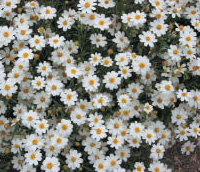
Blackfoot Daisy |
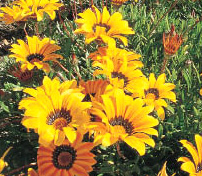
gazania |
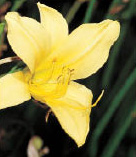
daylily |
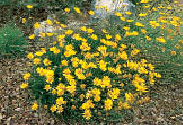
Angelita Daisy |
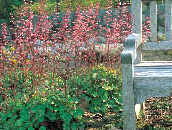
coral bells |
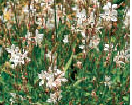
Gaura |
| Botanical Name Common Name |
How to Grow Water, Sun, Temp. |
Description Mature Size Flowers Bloom Season |
||
|---|---|---|---|---|
Gaura lindheimeri Gaura |
 |
 |
10° | Grows 1 foot high, spreading up to 1-1/2 feet wide. Frilly white to pink flowers bloom on tall spikes summer into fall. Cut plants back in winter to encourage new, healthy growth. May be sold in nurseries as butterfly flower. |
Gazania hybrids gazania |
 |
15° | Grows 1 to 3 feet high with gray-green leaves. Large delicate flowers on long stems may be salmon, orange, yellow, lavender or white. Locate plants where they will receive afternoon shade. Plant in a rich, organic soil. Cut back winter-dormant plants for regrowth the following spring. | |
Gypsophila paniculata baby’s breath |
 |
0° | ‘Bristol Fairy’ is an improved selection, growing to 3 feet high. Large loose clusters of tiny, double white flowers bloom profusely through summer on bluish green stems. Heat tolerant. | |
Hemerocallis hybrids daylily |
 |
 |
0° | Both evergreen and deciduous hybrids are available. Plants form a clump of slender arching leaves. Flowers in clusters bloom at the ends of tall stems midspring to early fall. They resemble lilies and come in many colors, including yellow, orange, red and many pastel shades. |
Hesperis matronalis dame’s rocket |
 |
0° | Produces purple and white flowers similar to those of phlox, borne in loose heads at ends of the stems. Flowers are fragrant, especially at night. Plants grow 2 to 3 feet high. Locate in full sun or partial shade in moist, well-drained soil. Easy to grow from seed. | |
Heuchera sanguinea coral bells |
 |
0° | Grows 6 to 12 inches high with rounded leaves. Flowers are borne in clusters in coral, reddish pink, white or crimson and bloom on top of 1- to 2-foot stems. Locate in partial shade in fertile, well-drained soil. | |
Hymenoxys acaulis Angelita Daisy |
 |
10° | Grows 1 foot high and as wide in a rounded clumping form. Profuse numbers of golden yellow, daisylike flowers on stems above medium green leaves bloom throughout the year. Tuck into small spaces among boulders, or combine with cacti and succulents. Best with afternoon shade. | |
Lavandula stoechas Spanish lavender |
 |
15° | The most heat-tolerant lavender, growing 3 to 4 feet high with an equal spread. Mounding plants have blue-green foliage, complementing lavender-blue flower spikes that bloom in late spring and summer. Flowers and foliage are fragrant. Plants accept some shade, prefer it in the afternoon. | |
Melampodium leucanthum Blackfoot Daisy |
 |
0° | Spreading, mounding, ground cover perennial grows 1 foot high and up to 2 feet wide. White daisylike flowers with yellow centers bloom throughout the year. Does best in well-drained soil and with afternoon shade. Great choice to include in a natural garden. | |
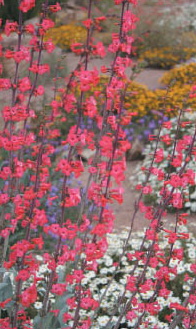
parry’s penstemon |
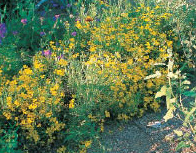
paperflower |
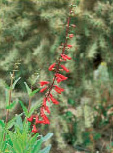
firecracker penstemon |
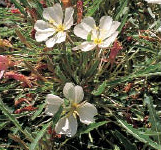
white evening primrose |
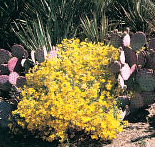
texas paperflower |
| Botanical Name Common Name |
How to Grow Water, Sun, Temp. |
Description Mature Size Flowers Bloom Season |
||
|---|---|---|---|---|
Nierembergia caerulea dwarf cup flower |
 |
 |
30° | Low-growing, reaching 8 to 10 inches high. Flowers are 1 inch long, bell-shaped, in rich blue to violet or white. Plant in fall or winter for flowers in summer. Best with afternoon shade or in partial shade in well-prepared soil. Remove spent blooms, which encourages more flowers. |
Oenothera caespitosa white evening |
 |
5° | Evergreen with large, gray-green leaves and masses of large, 4-inch white flowers. Blooms on and off throughout the year but most prolific in spring. Plants form rounded clumps 1 to 1-1/2 feet high, spreading 3 feet wide. May die out in summer if overwatered. Reseeds readily. | |
Penstemon baccharifolius rock penstemon |
 |
5° | Growth is different than most penstemons in that it is more shrublike to 2 feet high. ‘Del Rio’ is an improved selection, with cherry colored flowers blooming spring through fall. Loved by hummingbirds. Provide good soil drainage to prevent root diseases. | |
Penstemon eatonii firecracker penstemon |
 |
 |
0° | This plant is among the first to bloom in early spring. Tubular scarlet flowers appear on 3- to 4-foot stems above basal growth to 2 feet high and as wide. Plant in full sun—a shady location can cause plants to sprawl. Best in well-drained soils. Reseeds readily. Attracts hummingbirds. |
Penstemon parryi parry’s penstemon |
 |
18° | Tall, strongly vertical, 3- to 5-foot stems show off flowers in shades of pink. Widely adapted to desert regions. Accepts full sun but better with filtered or afternoon shade in low desert. Plant in soil with good drainage. After flowers set seed, cut back to top of leaf rosette. | |
Penstemon pseudospectabilis canyon penstemon |
 |
0° | Grows 1-1/2 to 2 feet high with typical penstemon rosette form. In spring, tubular flowers in shades of purple appear above the basal growth on stems to 2 feet high. Plant in full sun—a shady location can cause plants to sprawl. Best in well-drained soils. Reseeds readily. Attracts hummingbirds. | |
Penstemon superbus superb Penstemon |
 |
15° | One of the largest penstemons, growing to 2 feet high and up to 3 feet wide. Brilliant, coral colored, tubular flowers bloom on tall stems in late spring. Best in well-drained soils. Accepts some shade. Reseeds readily. Attracts hummingbirds. | |
Psilostrophe cooperi paperflower |
 |
10° | Plants grow 1 foot high, spreading to 2 feet wide. Evergreen foliage is gray-green. Yellow, daisylike flowers about 1 inch in diameter cover plants for long periods spring through fall. Will accept partial shade. Don’t overwater; combines well with cacti. | |
Psilostrophe tagetina texas paperflower blanket flower |
 |
-20° | Shrubby evergreen that covers itself with bright yellow flowers from spring through summer and late fall. Growth is mounding to 1-1/2 feet high, spreading to 3 feet wide. After the blossoms dry and turn papery, they maintain their yellow color. Locate in full sun to partial shade. | |
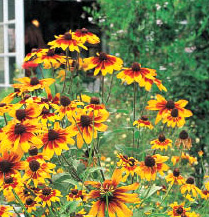
black-eyed susan |
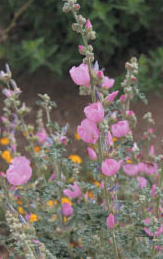
Globe Mallow |
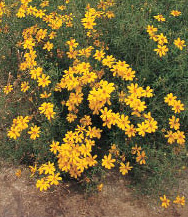
licorice marigold |
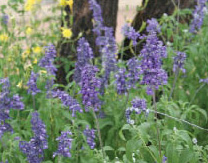
Mealy cup sage |
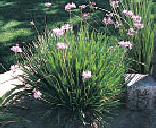
society garlic |
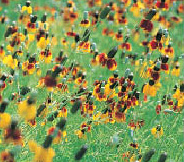
Mexican Hat |
| Botanical Name Common Name |
How to Grow Water, Sun, Temp. |
Description Mature Size Flowers Bloom Season |
||
|---|---|---|---|---|
Ratibida columnaris Mexican Hat |
 |
10° | Wildflower perennial, growing to 2 feet high and as wide. Plant in masses for best effect and to enjoy the interesting yellow or maroon flowers. They bloom at tips of long stems, the petals draping downward, surrounding dark cones in the flower’s center. Blooms spring to fall. | |
Rudbeckia hirta black-eyed susan |
 |
-10° | Plants grow to 3 feet or more high. Large, showy, yellow-orange flowers are excellent for cutting and bloom all summer and into fall. Plant in full sun in almost any soil, spring to late fall. Cut back after bloom period. Can be grown as an annual with a fall sowing. | |
Salvia farinacea mealy cup sage |
 |
-10° | Grows 1-1/2 to 2 feet high with an equal spread. Violet-blue flower spikes bloom for a long period through summer. Effective planted in masses. Best in full sun. Native to New Mexico and Texas. Attracts hummingbirds. | |
Salvia X superba blue queen sage |
 |
 |
10° | Compact plant to 12 inches high produces deep blue flower spikes from early summer until frost. Attractive when planted in masses. Best in full sun location with regular summer irrigation. Deadhead spent flowers frequently to increase flower production. |
Sphaeralcea ambigua Globe Mallow |
 |
5° | Shrubby wildflower perennial that grows to 3 feet high and as wide. Coarse-textured leaves are gray-green. Small, cup-shaped flowers bloom in spring. They come in many colors; the species is orange. Be careful while handling plants—they can irritate eyes and skin of some individuals. | |
Tagetes lucida licorice marigold |
 |
20° | A fall bloomer with flowers that are similar to mountain marigold, Tagetes lemmonii, but growth habit is more compact at 3 to 4 feet high. Leaves emit a scent of anise. Midsummer pruning controls growth and helps produce stronger stems to support flowers. May go dormant in winter. | |
Tulbaghia violacea society garlic |
 |
0° | Rosy lavender flowers bloom in large clusters in spring and summer; their long-term beauty help make up for the plant’s garlic scent. Flowers bloom on tall stems well above leaves, and foliage develops into large clumps. Grow in well-drained soil. Cut back in early spring to renew growth. | |
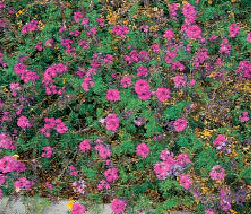
Moss verbena 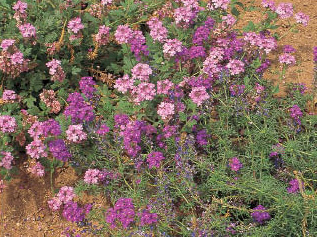
verbena species |
||
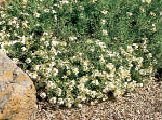
Desert Zinnia |
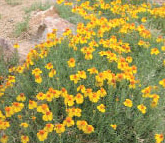
prairie zinnia |
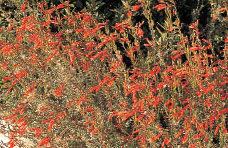
california fuschia |
| Botanical Name Common Name |
How to Grow Water, Sun, Temp. |
Description Mature Size Flowers Bloom Season |
||
|---|---|---|---|---|
Verbena peruviana peruvian verbena |
 |
10° | Forms a low, dense, evergreen mat of dark green foliage 4 to 16 inches high. Plant in full sun, 18 inches apart for ground cover. Puts on spectacular displays of brilliant, crimson-red or pink flowers spring through fall. Look for ‘Lipstick’, purple flowers; ‘Red’, red flowers; ‘St. Paul’, pink flowers. | |
Verbena pulchella moss verbena |
 |
-10° | (Verbena tenuisecta). Low-growing ground cover verbena to 1 foot high, spreading to 3 feet wide. Fine-textured dark green leaves serve as background to purple flowers in clusters. They bloom spring to fall. Attracts butterflies. | |
Verbena rigida sandpaper verbena |
 |
-10° | (Verbena venosa). A vigorous grower from 12 to 20 inches high with dark green, rough-toothed leaves. Stems support lilac to purple-blue flowers in clusters summer and fall. Like most verbenas, plants perform better if their leaves remain dry. Irrigate with drip system rather than overhead sprinklers. | |
Zauschneria californica california fuschia |
 |
 |
10° | Upright stems 8 to 12 inches high form a mat composed of small gray to green leaves. Bright orange-red or white tubular flowers are borne in clusters at ends of stems early summer through winter, which are loved by hummingbirds. Can become invasive if regular moisture is available. |
Zephyranthes candida Rain Lily |
 |
5° | Grows 1 foot high and as wide in a clumping form with thin, upright leaves. White star-shaped flowers typically bloom following summer rains. Also consider Zephranthes grandiflora, a similar species with pink flowers. | |
Zinnia acerosa Desert Zinnia |
 |
20° | Grows less than 1 foot high, spreading to 1 foot wide. White daisylike flowers are small but bloom for a long period—spring into fall. Excellent mounding plant to spread amongst rocks and boulders. Accepts tough conditions and low water. | |
Zinnia grandiflora prairie zinnia |
 |
0° | Grows 1 foot high and as wide. Spreads to fill in nooks among rocks and boulders. Flowers are yellow to orange, similar in appearance to desert zinnia, with a bloom period from summer to fall. Flowers attract butterflies. Accepts some shade. | |
Brought to you by Coachella Valley Water District